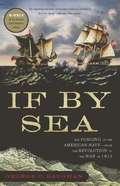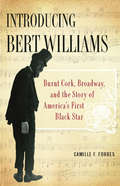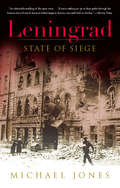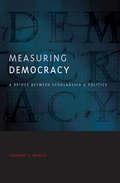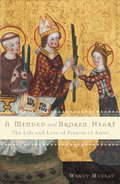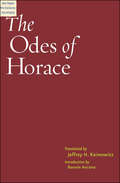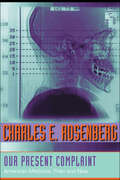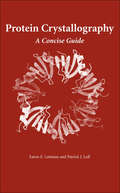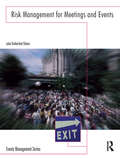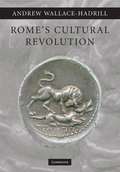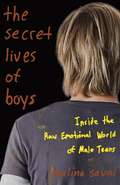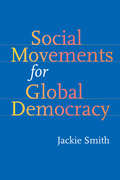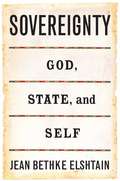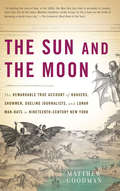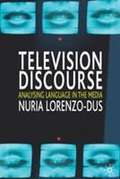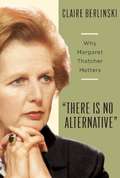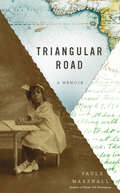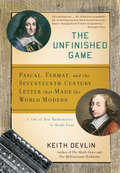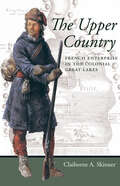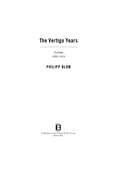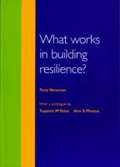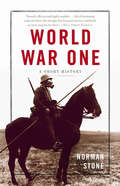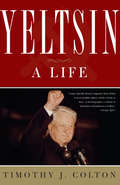- Table View
- List View
If By Sea: The Forging of the American Navy--from the Revolution to the War of 1812
by George C. DaughanThe American Revolution-and thus the history of the United States-began not on land but on the sea. Paul Revere began his famous midnight ride not by jumping on a horse, but by scrambling into a skiff with two other brave patriots to cross Boston Harbor to Charlestown. Revere and his companions rowed with muffled oars to avoid capture by the British warships closely guarding the harbor. As they paddled silently, Revere's neighbor was flashing two lanterns from the belfry of Old North Church, signaling patriots in Charlestown that the redcoats were crossing the Charles River in longboats. In every major Revolutionary battle thereafter the sea would play a vital, if historically neglected, role. When the American colonies took up arms against Great Britain, they were confronting the greatest sea-power of the age. And it was during the War of Independence that the American Navy was born. But following the British naval model proved crushingly expensive, and the Founding Fathers fought viciously for decades over whether or not the fledgling republic truly needed a deep-water fleet. The debate ended only when the Federal Navy proved indispensable during the War of 1812. Drawing on decades of prodigious research, historian George C. Daughan chronicles the embattled origins of the U.S. Navy. From the bloody and gunpowder-drenched battles fought by American sailors on lakes and high seas to the fierce rhetorical combat waged by the Founders in Congress, If By Sea charts the course by which the Navy became a vital and celebrated American institution.
Introducing Bert Williams: Burnt Cork, Broadway, and the Story of America's First Black Star
by Camille F. ForbesAccording to critics of his time, Bert Williams was "the Greatest Comedian on the American Stage.” A black Bahamian immigrant, Williams made his start as a barker advertising the rough-and-tumble "medicine shows” that dotted the Wild West at the end of the nineteenth century. Not long after joining a minstrel troupe and donning the burnt- cork makeup of blackface, he teamed up with African American George Walker in a sixteen-year partnership that would take them from rural western mining towns to the bright lights of Broadway.In Introducing Bert Williams, historian Camille Forbes reveals a fascinating figure, initiating the reader into the vivid world of nineteenth- and early twentieth-century popular entertainment. Williams's long and varied career is a whirlwind of drama, glamour, and ambition-nothing less than the birth of American show business.
Leningrad: State of Siege
by Michael Jones"All offers of surrender from Leningrad must be rejected,” wrote Adolph Hitler on September 29, 1941, at the outset of Operation Barbarossa. "In this struggle for survival, we have no interest in keeping even a proportion of the city's population alive.”During the famed 900-day siege of Leningrad, the German High Command deliberately planned to eradicate the city's population through starvation. Viewing the Slavs as sub-human, Hitler embarked on a vicious program of ethnic cleansing. By the time the siege ended in January 1944, almost a million people had died. Those who survived would be marked permanently by what they endured as the city descended into chaos.In Leningrad, military historian Michael Jones chronicles the human story of this epic siege. Drawing on newly available eyewitness accounts and diaries, he reveals the true horrors of the ordeal-including stories long-suppressed by the Soviets of looting, criminal gangs, and cannibalism. But he also shows the immense psychological resources on which the citizens of Leningrad drew to survive against desperate odds. At the height of the siege, for instance, an extraordinary live performance of Shostakovich's Seventh Symphony profoundly strengthened the city's will to resist.A riveting account of one of the most harrowing sieges of world history, Leningrad also portrays the astonishing power of the human will in the face of even the direst catastrophe.
Measuring Democracy: A Bridge between Scholarship and Politics (Democratic Transition and Consolidation)
by Gerardo L. MunckAlthough democracy is a widely held value, concrete measurement of it is elusive. Gerardo L. Munck’s constructive assessment of the methods used to measure democracies promises to bring order to the debate in academia and in practice.Drawing on his years of academic research on democracy and measurement and his practical experience evaluating democratic practices for the United Nations and the Organization of American States, Munck's discussion bridges the theories of academia with practical applications. In proposing a more open and collaborative relationship between theory and action, he makes the case for reassessing how democracy is measured and encourages fundamental changes in methodology. Munck’s field-tested framework for quantifying and qualifying democracy is built around two instruments he developed: the UN Development Programme’s Electoral Democracy Index and a case-by-case election monitoring tool used by the OAS.Measuring Democracy offers specific, real-world lessons that scholars and practitioners can use to improve the quality and utility of data about democracy.
A Mended and Broken Heart: The Life and Love of Francis of Assisi
by Wendy MurrayFrancis of Assisi is Catholicism&’s most popular saint. Tens of millions of spiritual seekers summon his name and example. But the real Francis-both his complicated personality and his complex theology-have been misunderstood for centuries. In 1228, Pope Gregory IX rushed to canonize St. Francis only two years after his death. Soon thereafter, the Church eliminated significant aspects of his biography from the public record. For Francis&’s early life was defined by his profligacy; shortly before dying, Francis himself warned his brothers: &“Don&’t be too quick to canonize me. I am perfectly capable of fathering a child.&” In A Mended and Broken Heart, journalist Wendy Murray slices through the bowdlerized version of Francis&’s life promoted within the Catholic tradition and reveals instead a saint who was in every way also a real man. Murray stresses in particular the crucial but completely neglected role that Clare of Assisi played in Francis&’s life, both pre- and postconversion, and his theology. A profoundly humane portrait of a misunderstood saint, A Mended and Broken Heart makes a powerful case that St. Francis&’s life and thought make him a role model for religious seekers of every faith.
Mere Thermodynamics
by Don S. LemonsPresenting classical thermodynamics as a concise and discrete whole, Mere Thermodynamics is a perfect tool for teaching a notoriously difficult subject.Accomplished teacher Don S. Lemons introduces the physical theory's concepts and methods and uses them to solve problems from a broad range of physics. He illustrates, at a gentle pace, not only the fundamentals of the subject but also advanced topics such as the relationship between the second law of thermodynamics and entropy. He highlights the intellectual structure and history of the discipline and explores the logical consequences of each of the famous three laws. Lemons explains and develops the first two laws and their corollaries, the methods and applications of thermodynamics, and the third law, as well as non-fluid variables, equilibrium and stability, and two-phase systems.The book features end-of-chapter practice problems, an appendix of worked problems, a glossary of terms, and an annotated bibliography.
The Odes of Horace (Johns Hopkins New Translations from Antiquity)
by Horace (Quintus Horatius Flaccus)This groundbreaking new translation of Horace’s most widely read collection of poetry is rendered in modern, metrical English verse rather than the more common free verse found in many other translations. Jeffrey H. Kaimowitz adapts the Roman poet's rich and metrically varied poetry to English formal verse, reproducing the works in a way that maintains fidelity to the tone, timbre, and style of the originals while conforming to the rules of English prosody. Each poem is true to the sense and aesthetic pleasure of the Latin and carries with it the dignity, concision, and movement characteristic of Horace’s writing. Kaimowitz presents each translation with annotations, providing the context necessary for understanding and enjoying Horace's work. He also comments on textual instability and explains how he constructed his verse renditions to mirror Horatian Latin. Horace and The Odes are introduced in lively fashion by noted classicist Ronnie Ancona.
Our Present Complaint: American Medicine, Then and Now
by Charles E. RosenbergCharles E. Rosenberg, one of the world's most influential historians of medicine, presents a fascinating analysis of the current tensions in American medicine. Situating these tensions within their historical and social contexts, Rosenberg investigates the fundamental characteristics of medicine: how we think about disease, how the medical profession thinks about itself and its moral and intellectual responsibilities, and what prospective patients—all of us—expect from medicine and the medical profession. He explores the nature and definition of disease and how ideas of disease causation reflect social values and cultural negotiations. His analyses of alternative medicine and bioethics consider the historically specific ways in which we define and seek to control what is appropriately medical. At a time when clinical care and biomedical research generate as much angst as they offer cures, this volume provides valuable insight into how the practice of medicine has evolved, where it is going, and how lessons from history can improve its prognosis.
Protein Crystallography: A Concise Guide
by Eaton E. Lattman Patrick J. LollThe proteome remains a mysterious realm. Researchers have determined the structures of only a small fraction of the proteins encoded by the human genome. Crystallography continues to be the primary method used to determine the structures of the remaining unknown proteins. This imaging technique uses the diffraction of X-rays to determine a protein’s three-dimensional molecular structure.Drawing on years of research and teaching experience, Eaton E. Lattman and Patrick J. Loll use clear examples and abundant illustrations to provide a concise and accessible primer on protein crystallography. Discussing the basics of diffraction, the behavior of two- and three-dimensional crystals, phase determination (including MIR and MAD phasing and molecular replacement), the Patterson function, and refinement, Lattman and Loll provide a complete overview of this important technique, illuminated by physical insights.The crisp writing style and simple illustrations will provide beginner crystallographers with a guide to the process of unraveling protein structure.
Risk Management for Meetings and Events (1st Edition)
by Julia Rutherford SilversEvents of all types are produced every day for all manner of purposes, attracting all sorts of people. Creating and managing the environment in which these people will gather carries with it awesome responsibilities - legal, ethical, and financial. To provide a safe and secure setting and to operate in a manner that ensures the hosting organizations or individuals achieve their objectives in a proper and profitable way, event risk management must be fully integrated into all event plans and throughout the event management process.Risk Management for Meetings and Events examines the practices, procedures, and safeguards associated with the identification, analysis, response planning, and control of the risks surrounding events of all types. Written by an experienced author it:* Provides a solid, easy-to-read conceptual foundation based on proven risk management techniques* Includes ready-to-use templates designed specifically as learning exercises for students and professionals* Comprehensively discusses effective strategies for managing the risks associated with design, planning and production of public and private events Risk Management for Meetings and Events is a comprehensive and practical guide which supports academic and professional development programs that prepare individuals for entering or advancement in the meeting and event management industry.
Risk Management for Meetings and Events (1st Edition) (PDF)
by Julia Rutherford SilversEvents of all types are produced every day for all manner of purposes, attracting all sorts of people. Creating and managing the environment in which these people will gather carries with it awesome responsibilities - legal, ethical, and financial. To provide a safe and secure setting and to operate in a manner that ensures the hosting organizations or individuals achieve their objectives in a proper and profitable way, event risk management must be fully integrated into all event plans and throughout the event management process.Risk Management for Meetings and Events examines the practices, procedures, and safeguards associated with the identification, analysis, response planning, and control of the risks surrounding events of all types. Written by an experienced author it:* Provides a solid, easy-to-read conceptual foundation based on proven risk management techniques* Includes ready-to-use templates designed specifically as learning exercises for students and professionals* Comprehensively discusses effective strategies for managing the risks associated with design, planning and production of public and private events Risk Management for Meetings and Events is a comprehensive and practical guide which supports academic and professional development programs that prepare individuals for entering or advancement in the meeting and event management industry.
Rome's Cultural Revolution (PDF)
by Andrew Wallace-HadrillDrawing equally on archaeological and literary evidence, this book offers an original interpretation of the fundamental transformations of Rome's society, culture and identity during the period of its imperial expansion.
The Secret Lives of Boys: Inside the Raw Emotional World of Male Teens
by Malina SavalTeenage boys have come a long way since the staid 1980s when they were all lumped into the Breakfast Club categories of Brains, Druggies, and Jocks. Crisscrossing the country-meeting with boys from different cultures, and socioeconomic backgrounds-journalist Malina Saval introduces readers to the next generation of male teens by creating new archetypes and redrawing the ever-expanding social map. The Secret Lives of Boys offers an uncensored look into boyhood that reveals the spine-tingling confessions, heartrending sadness and isolation, unbridled optimism, and seemingly boundless resilience of male teens today. Saval asks the pertinent questions: Who are these boys? What do they think of themselves? A compelling and candid look at male adolescence in the twenty-first century, The Secret Lives of Boys uncovers what our young people want you to know.
Social Movements for Global Democracy (Themes in Global Social Change)
by Jackie SmithThis groundbreaking study sheds new light on the struggle to define the course of globalization. Synthesizing extensive research on transnational activism, Social Movements for Global Democracy shows how transnational networks of social movement activists—democratic globalizers—have worked to promote human rights and ecological sustainability over the predominant neoliberal system of economic integration.Using case studies of recent and ongoing campaigns for global justice, Jackie Smith provides valuable insight into whether and how these activists are succeeding. She argues that democratic globalizers could be more effective if they presented a united front organized around a global vision that places human rights and ecological stability foremost and if they were to directly engage governments and the United Nations.Illuminating the deep-seated struggles between two visions of globalization, Smith reveals a network of activists who have long been working to democratize the global political system.
Sovereignty: God, State, and Self
by Jean Bethke ElshtainThroughout the history of human intellectual endeavor, sovereignty has cut across the diverse realms of theology, political thought, and psychology. From earliest Christian worship to the revolutionary ideas of Thomas Jefferson and Karl Marx, the debates about sovereignty—complete independence and self-government—have dominated our history.In this seminal work of political history and political theory, leading scholar and public intellectual Jean Bethke Elshtain examines the origins and meanings of &“sovereignty&” as it relates to all the ways we attempt to explain our world: God, state, and self. Examining the early modern ideas of God which formed the basis for the modern sovereign state, Elshtain carries her research from theology and philosophy into psychology, showing that political theories of state sovereignty fuel contemporary understandings of sovereignty of the self. As the basis of sovereign power shifts from God, to the state, to the self, Elshtain uncovers startling realities often hidden from view. Her thesis consists in nothing less than a thorough-going rethinking of our intellectual history through its keystone concept.The culmination of over thirty years of critically applauded work in feminism, international relations, political thought, and religion, Sovereignty opens new ground for our understanding of our own culture, its past, present, and future.
The Sun and the Moon: The Remarkable True Account of Hoaxers, Showmen, Dueling Journalists, and Lunar Man-Bats in Nineteen
by Matthew GoodmanOn August 26, 1835, a fledgling newspaper called the Sun brought to New York the first accounts of remarkable lunar discoveries. A series of six articles reported the existence of life on the moon-including unicorns, beavers that walked on their hind legs, and four-foot-tall flying man-bats. In a matter of weeks it was the most broadly circulated newspaper story of the era, and the Sun, a working-class upstart, became the most widely read paper in the world.An exhilarating narrative history of a divided city on the cusp of greatness, and tale of a crew of writers, editors, and charlatans who stumbled on a new kind of journalism, The Sun and the Moon tells the surprisingly true story of the penny papers that made America a nation of newspaper readers.
Television Discourse: Analysing Language In The Media (PDF)
by Nuria Lorenzo-DusWhat is the connection between what is said on TV and how it is said? Structured around key features of television discourse, Nuria Lorenzo-Dus examines the specific forms and structures of talk across media genres. Using data from programs as varied as news bulletins and political speeches to makeover and talk shows,Television Discourse examines four defining characteristics of the current broadcast landscape: Storytelling, Closeness, Conflict and Persuasion. This innovative, four-part structure allows for detailed discourse analysis of how each feature works in context; whilst 'Storytelling' is examined in relation to docu-soaps and talk shows, 'Closeness' is explored through the mediums of celebrity chat shows and reality programming. Insightful analysis of 'Conflict' in courtroom shows and 'Persuasion' in lifestyle programs enables readers to think critically about the ways in which television discourse is used to influence the viewer. With a helpful glossary and extensive guide to further reading,Television Discourse is an invaluable resource for all those interested in studying language in the media.
There Is No Alternative: Why Margaret Thatcher Matters
by Claire BerlinskiGreat Britain in the 1970s appeared to be in terminal decline-ungovernable, an economic train wreck, and rapidly headed for global irrelevance. Three decades later, it is the richest and most influential country in Europe, and Margaret Thatcher is the reason. The preternaturally determined Thatcher rose from nothing, seized control of Britain's Conservative party, and took a sledgehammer to the nation's postwar socialist consensus. She proved that socialism could be reversed, inspiring a global free-market revolution. Simultaneously exploiting every politically useful aspect of her femininity and defying every conventional expectation of women in power, Thatcher crushed her enemies with a calculated ruthlessness that stunned the British public and without doubt caused immense collateral damage.Ultimately, however, Claire Berlinski agrees with Thatcher: There was no alternative. Berlinski explains what Thatcher did, why it matters, and how she got away with it in this vivid and immensely readable portrait of one of the towering figures of the twentieth century.
Triangular Road: A Memoir
by Paule MarshallIn Triangular Road, famed novelist Paule Marshall tells the story of her years as a fledgling young writer in the 1960s. A memoir of self-discovery, it also offers an affectionate tribute to the inimitable Langston Hughes, who entered Marshall's life during a crucial phase and introduced her to the world of European letters during a whirlwind tour of the continent. In the course of her journeys to Europe, Barbados, and eventually Africa, Marshall comes to comprehend the historical enormity of the African diaspora, an understanding that fortifies her sense of purpose as a writer.In this unflinchingly honest memoir, Paule Marshall offers an indelible portrait of a young black woman coming of age as a novelist in a literary world dominated by white men.
The Unfinished Game: Pascal, Fermat, and the Seventeenth-Century Letter that Made the World Modern (Basic Ideas Ser.)
by Keith DevlinIn the early seventeenth century, the outcome of something as simple as a dice roll was consigned to the realm of unknowable chance. Mathematicians largely agreed that it was impossible to predict the probability of an occurrence. Then, in 1654, Blaise Pascal wrote to Pierre de Fermat explaining that he had discovered how to calculate risk. The two collaborated to develop what is now known as probability theory-a concept that allows us to think rationally about decisions and events.In The Unfinished Game, Keith Devlin masterfully chronicles Pascal and Fermat's mathematical breakthrough, connecting a centuries-old discovery with its remarkable impact on the modern world.
The Upper Country: French Enterprise in the Colonial Great Lakes (Regional Perspectives on Early America)
by Claiborne A. SkinnerThe Upper Country melds myth and conventional history to provide a memorable tale of French designs in the middle of what became the United States. Putting the reader on the battlefields, at the trading posts, and on the rivers with voyageurs and their allies from the Indian nations, Claiborne Skinner reveals the saintly missionaries and jolly fur traders of popular myth as agents of a hard-nosed, often ruthless, imperial endeavor. Skinner’s engaging narrative takes the reader through daily life at posts like Forts Saint Louis and Michilimakinac, illuminates the complexities of interracial marriage with the courtship of Michel Aco at Peoria, and explains how France's New World adventurism played a role in the outbreak of the Seven Years War and the beginning of the modern era.In this story, many of the traditional heroes and villains of American history take on surprising roles. The last Stuart kings of England seem shrewd and even human; George Washington makes his debut appearance on the stage of history by assassinating a French officer and plunging Europe into the first truly global war. From unthinkable hardship to dreams of fur trade profits, this fascinating exploration sheds new light on France and its imperial venture into the Great Lakes.
The Vertigo Years: Europe, 1900-1914
by Philipp BlomEurope, 1900-1914: a world adrift, a pulsating era of creativity and contradictions. The major topics of the day: terrorism, globalization, immigration, consumerism, the collapse of moral values, and the rivalry of superpowers. The twentieth century was not born in the trenches of the Somme or Passchendaele-but rather in the fifteen vertiginous years preceding World War I.In this short span of time, a new world order was emerging in ultimately tragic contradiction to the old. These were the years in which the political and personal repercussions of the Industrial Revolution were felt worldwide: Cities grew like never before as people fled the countryside and their traditional identities; science created new possibilities as well as nightmares; education changed the outlook of millions of people; mass-produced items transformed daily life; industrial laborers demanded a share of political power; and women sought to change their place in society-as well as the very fabric of sexual relations.From the tremendous hope for a new century embodied in the 1900 World's Fair in Paris to the shattering assassination of a Habsburg archduke in Sarajevo in 1914, historian Philipp Blom chronicles this extraordinary epoch year by year. Prime Ministers and peasants, anarchists and actresses, scientists and psychopaths intermingle on the stage of a new century in this portrait of an opulent, unstable age on the brink of disaster.Beautifully written and replete with deftly told anecdotes, The Vertigo Years brings the wonders, horrors, and fears of the early twentieth century vividly to life.
What Works in Building Resilience? (PDF)
by Tony NewmanThis books reviews strategies, interventions and approaches that can help build resilience in children and young people. It is aimed at social care professionals.
World War One: A Short History
by Norman StoneThe First World War was the overwhelming disaster from which everything else in the twentieth century stemmed. Fourteen million combatants died, four empires were destroyed, and even the victors' empires were fatally damaged. World War I took humanity from the nineteenth century forcibly into the twentieth-and then, at Versailles, cast Europe on the path to World War II as well. In World War One, Norman Stone, one of the world's greatest historians, has achieved the almost impossible task of writing a terse and witty short history of the war. A captivating, brisk narrative, World War One is Stone's masterful effort to make sense of one of the twentieth century's pivotal conflicts.
Yeltsin: A Life
by Timothy J. ColtonEven after his death in April 2007, Boris Yeltsin remains the most controversial figure in recent Russian history. Although Mikhail Gorbachev presided over the decline of the Communist party and the withdrawal of Soviet control over eastern Europe, it was Yeltsin-Russia's first elected president-who buried the Soviet Union itself. Upon taking office, Yeltsin quickly embarked on a sweeping makeover of newly democratic Russia, beginning with a program of excruciatingly painful market reforms that earned him wide acclaim in the West and deep recrimination from many Russian citizens. In this, the first biography of Yeltsin's entire life, Soviet scholar Timothy Colton traces Yeltsin's development from a peasant boy in the Urals to a Communist party apparatchik, and then ultimately to a nemesis of the Soviet order. Based on unprecedented interviews with Yeltsin himself as well as scores of other Soviet officials, journalists, and businessmen, Colton explains how and why Yeltsin broke with single-party rule and launched his drive to replace it with democracy. Yeltsin's colossal attempt to bring democracy to Russia remains one of the great, unfinished stories of our time. As anti-Western policies and rhetoric resurface in Putin's increasingly bellicose Russia, Yeltsin offers essential insights into the past, present, and future of this vast and troubled nation.
